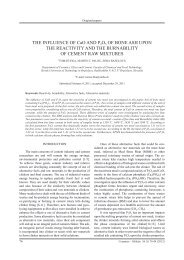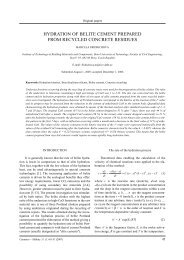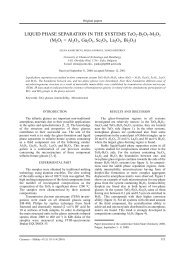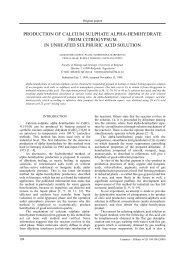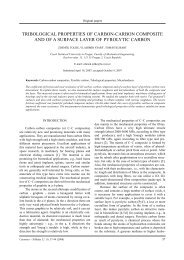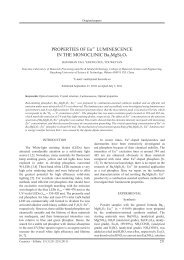Verification of the effect of concrete surface ... - Ceramics-Silikaty
Verification of the effect of concrete surface ... - Ceramics-Silikaty
Verification of the effect of concrete surface ... - Ceramics-Silikaty
Create successful ePaper yourself
Turn your PDF publications into a flip-book with our unique Google optimized e-Paper software.
Stehlík M., Novák J.<br />
Figure 3. Different carbonation depths in an atmosphere <strong>of</strong> 98% CO 2 and in <strong>the</strong> natural atmosphere both <strong>the</strong>oretically and<br />
practically.<br />
Figure 4. Acceleration <strong>of</strong> <strong>the</strong> carbonation depth test in 98%<br />
CO 2.<br />
Carbonation depth <strong>of</strong> common <strong>concrete</strong> placed in<br />
<strong>the</strong> natural atmosphere (0.03% CO 2) for a long time can<br />
be determined by calculation according to many authors<br />
(e.g. Henning, Lach [10], Matoušek, Drochytka [4], Seng<br />
Diep [11], Houst, Wittmann [17]). The relation according<br />
to [10] seems to be <strong>the</strong> most general one, <strong>the</strong> so-called<br />
Fick’s law in <strong>the</strong> following form<br />
x = k·√t (3)<br />
which is based on <strong>the</strong> principle <strong>of</strong> a constant increase <strong>of</strong><br />
carbonation depth with time. X indicates <strong>the</strong> depth <strong>of</strong><br />
<strong>the</strong> carbonated layer in mm, t is <strong>the</strong> time in days and k is<br />
<strong>the</strong> constant ranging from 0.2 to 0.4 (depending on <strong>the</strong><br />
cement type and <strong>the</strong> water ratio v/c). It is apparent that <strong>the</strong><br />
carbonation depth will be, according to <strong>the</strong> measurements<br />
carried out on <strong>the</strong> standard samples, partially dependent<br />
on <strong>the</strong> quality <strong>of</strong> <strong>concrete</strong>. It is also interesting that <strong>the</strong><br />
increase <strong>of</strong> carbonation depth calculated according<br />
to <strong>the</strong> Fick’s law [10] is roughly corresponding to <strong>the</strong><br />
carbonation depths found out in poor quality <strong>concrete</strong>s<br />
in <strong>the</strong> course <strong>of</strong> <strong>the</strong> one-year measurement. Figure 3<br />
shows a conventional curve <strong>of</strong> <strong>the</strong> increase <strong>of</strong> carbonation<br />
depth derived <strong>the</strong>oretically from <strong>the</strong> Fick’s law on <strong>the</strong><br />
one hand and from <strong>the</strong> one-year practical measurement<br />
in an environment <strong>of</strong> 0.03% CO 2 on <strong>the</strong> o<strong>the</strong>r hand, and<br />
simultaneously a growth curve for average <strong>concrete</strong> (30<br />
MPa in compression) determined by measurement in an<br />
environment <strong>of</strong> 98% CO 2.<br />
It is apparent from <strong>the</strong> chart in Figure 4 and from<br />
<strong>the</strong> following Table 2 that <strong>the</strong> speed <strong>of</strong> carbonation<br />
in an environment <strong>of</strong> concentrated 98% CO 2 constantly<br />
increases in comparison with <strong>the</strong> natural environment<br />
containing 0.03% CO 2. If <strong>the</strong> carbonation depth measured<br />
in <strong>the</strong> tested <strong>concrete</strong> in <strong>the</strong> accelerated test after<br />
two months <strong>of</strong> placement in 98% CO 2 is 10 mm, <strong>the</strong>n<br />
<strong>the</strong> same damage in <strong>the</strong> real environment <strong>of</strong> 0.03%<br />
CO 2 would occur in 312 days (10.4 months) - see<br />
Figure 4. However, <strong>the</strong> dependence between <strong>the</strong> time <strong>of</strong><br />
corresponding damage <strong>of</strong> <strong>concrete</strong>s in <strong>the</strong> concentrated<br />
and natural environments was determined for samples<br />
<strong>of</strong> common <strong>concrete</strong> with a 28-day strength <strong>of</strong> approx.<br />
30 MPa.<br />
RESULTS AND DISCUSSION<br />
The real carbonation depth <strong>of</strong> both <strong>surface</strong> treated<br />
and <strong>surface</strong> untreated mortar beams was always determined<br />
on both fragments <strong>of</strong> beams according to prEN<br />
14630:2003, Paragraph 4.2. This is an indication <strong>of</strong><br />
sound <strong>concrete</strong> by phenolphthalein (purple colouring)<br />
at pH > 9,4. The mutual comparison <strong>of</strong> carbonation<br />
depths <strong>of</strong> both <strong>the</strong> coated and uncoated samples (placed<br />
in 98% CO 2 and in <strong>the</strong> natural atmosphere <strong>of</strong> <strong>the</strong><br />
laboratory) was carried out in <strong>the</strong> following chronological<br />
order starting from <strong>the</strong> date <strong>of</strong> placement into 98%<br />
CO 2: 1 month, 2 months, 4 months, 6 months and <strong>the</strong><br />
last measurement after 12 months <strong>of</strong> placement in 98%<br />
CO 2. Following is a quick evaluation <strong>of</strong> <strong>the</strong> state <strong>of</strong><br />
carbonation <strong>of</strong> standard beams after <strong>the</strong> above mentioned<br />
time intervals.<br />
82 <strong>Ceramics</strong> – Silikáty 55 (1) 79-84 (2011)



